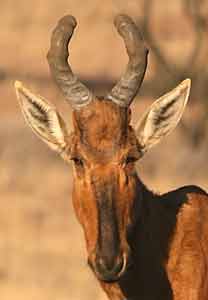Scotch Macaskill's Wildlife Blog
IMPORTANT: Please note that from April 2009 this Blog's Web address changed as a result of a switch in the blogging platform we use. It's still an integral part of the Wildlife Pictures Online website and, we hope, will continue providing entertaining and enjoyable content in the form of wildlife images, news, views and information.
For the most recent posts, links, and other resources, please visit the new Wldlife Photography Blog.
|
Today's Picture: Puff adder
July 1, 2007
|
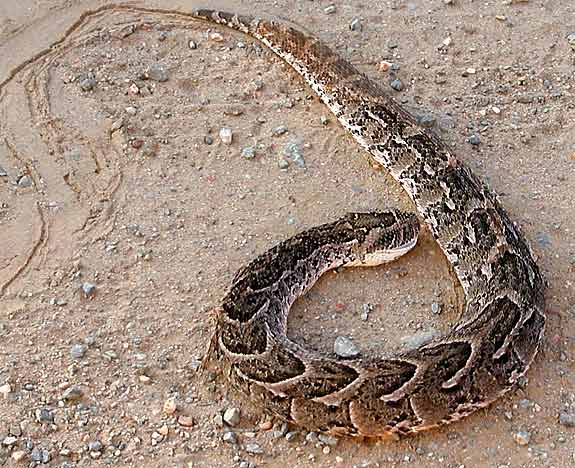
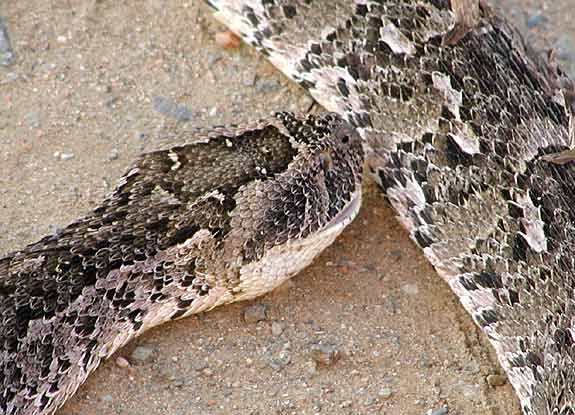
Photo Details: Puff adder (Bitis arietans) lying in the road, Kruger National Park, South Africa.
Camera: Olympus C2100 UZ; Shutter speed: 1/200; Aperture: f2.8; ISO: 100.
Additional Info: The puff adder is a venomous viper that is considered to be Africa's most dangerous snake, not only because it is so common and widespread throughout the continent (except for the Sahara and rain forest regions), but also because of its large size (average length about 1m) potent venom, and willingness to bite.
A sluggish species that relies on camouflage for protection, the puff adder moves primarily in a caterpillar fashion leaving a track in the sand (as in first photo above). However, when agitated it can resort to a typical serpentine movement and travel at surprising speed.
An angry puff adder is capable of striking in all directions at lightning speed, but fortunately it often gives warning of its intentions by hissing noisily. During a strike the force of the impact is so strong and the long fangs penetrate so deeply that small prey can be killed by the physical trauma alone.
Puff adder venom is strongly hemotoxic, destroying bloods cells and causing extensive tissue damage. About 100mg is thought to be enough to kill a healthy adult human male, with death occurring after 25 hours or more
|
Today's picture: Lion cub
July 5, 2007
|
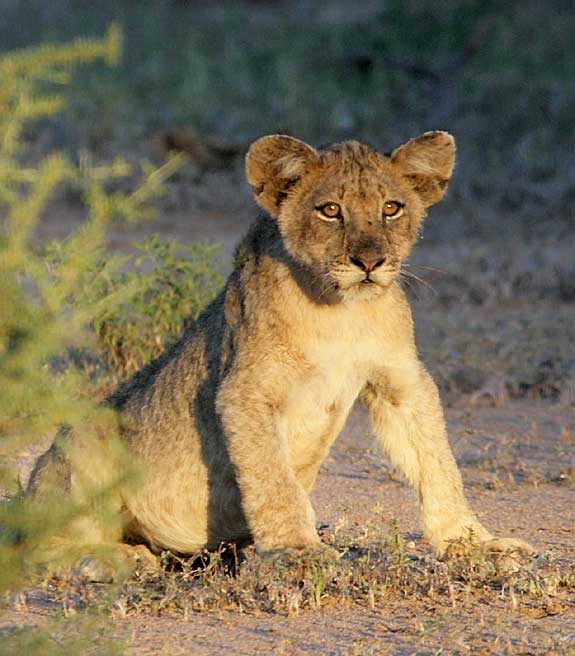
Photo Details: Lion cub (Panthera leo) caught in the last rays of afernoon sunshine, Mashatu Game Reserve, Tuli Block, Botswana.
Camera: Canon EOS 400D; Lens: Canon 100-400 IS Zoom; Focal Length: 400mm; Shutter speed: 1/320; Aperture: f5.6; ISO: 800.
|
Today's picture: Zebra at Waterhole
July 8, 2007
|
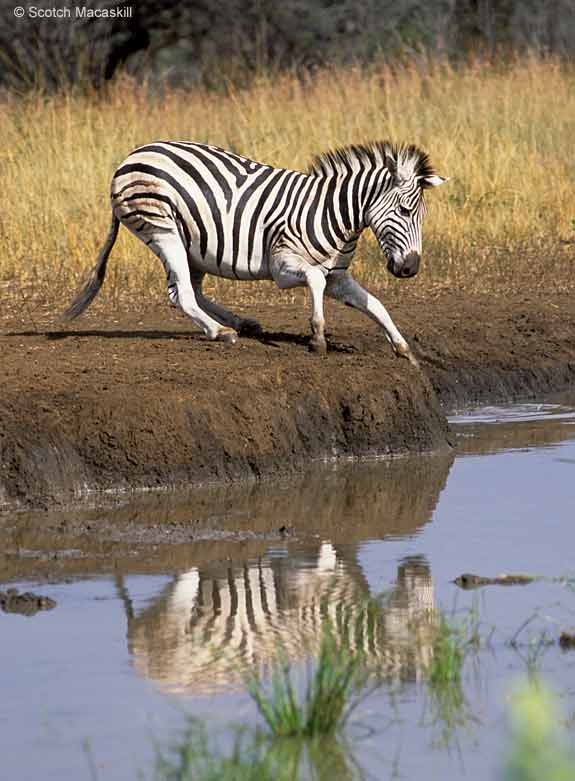
Photo Details: Plains or Burchell's Zebra (Equus quagga) hesitates briefly on edge of waterhole, Mkuzi Game Reserve, KwaZulu-Natal, South Africa.
Camera: Canon EOS 50E (Elan IIE) film camera; Lens: Canon 80-200 F2.8 Zoom; Film: Fujichrome Provia 100F (RDP III)
Additional Info: This photograph was taken some years ago, before I switched to a digital SLR camera. For me the image works mainly because of the pose - it depicts that brief moment of tension as the zebra braces itself on the edge of the waterhole before bending forward to drink.
All animals are vulnerable when crouching to drink and in this case the zebra is even more so, because the level of water has dropped. Once the zebra has its head down, any potential danger will be out of sight and the animal appears to be hesitating as it weighs up the risks.
Although colors in the African bush can often be quite muted - even dull - here they work well, with the shades of brown, yellow and olive contrasting with the blue of the water, while also allowing the zebra to stand out clearly against the background.
The line between land and water is curved and uneven, preventing the "mirror-image" effect where the picture is split into two equal halves. In this case the reflection is blurred and incomplete, broken by foliage in the water, giving it some interest of its own without detracting from the main subject.
|
Today's Picture: Young Nyala calf
July 16, 2007
|
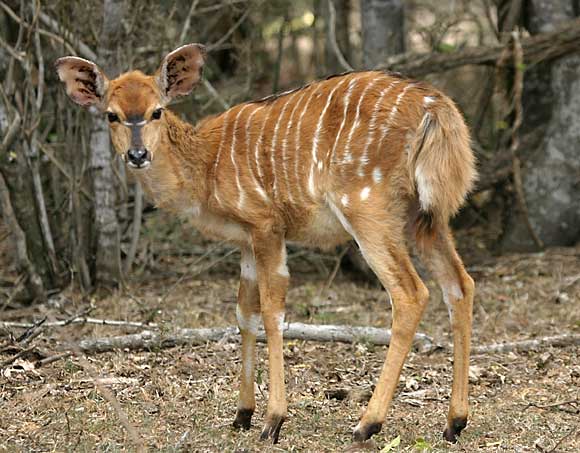
Photo Details: Young Nyala calf (Tragelaphus angasii), its mother not in sight, emerges briefly
from the cover of dense forest that can be seen in the background, Ndumo Game Reserve, KwaZulu-Natal, South
Africa.
Camera: Canon EOS 300D; Lens: Canon 100-400 IS Zoom; Focal Length: 190mm;
Shutter Speed: 1/200; Aperture: f5; ISO: 200
|
Today's picture: Woodland Kingfisher
July 23, 2007
|
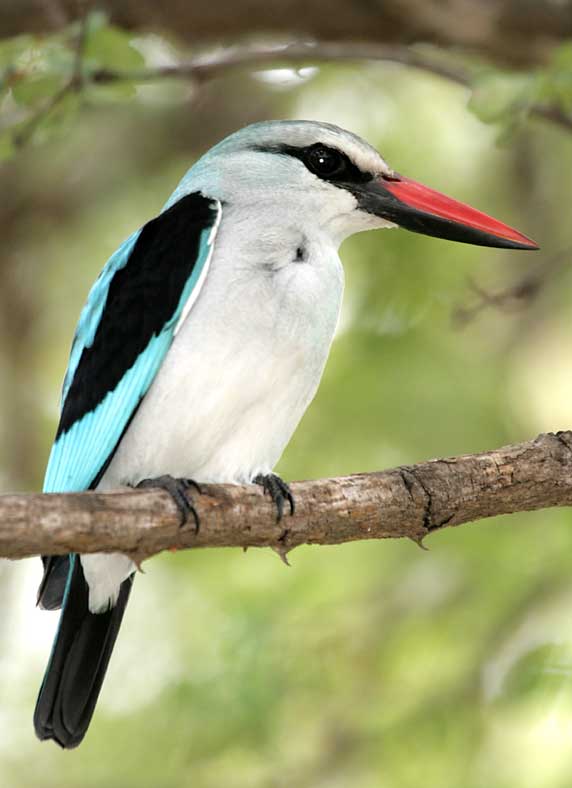
Photo Details: Woodland Kingfisher (Halcyon senegalensis) perches on a branch while scanning the grass below for insects, Kruger National Park, South Africa.
Camera: Canon EOS 400D; Lens: Canon 100-400 IS Zoom; Focal Length: 390mm; Shutter speed: 1/125; Aperture: f5.6; ISO: 400.
Additional Info: These small, attractive birds with their bright blue, white, and black coloring and distinctive red-topped bills are found in drier bushveld and riverine woodland from October to April.
If you're visiting one of southern Africa's game parks during summer you're more than likely to have good sightings of these kingfishers. Even if you don't see the birds, it's almost impossible not to hear their constant but melodious call as they flit from branch to branch while scanning the ground for insects.
|
Today's picture: Red Hartebeest
July 28, 2007
|
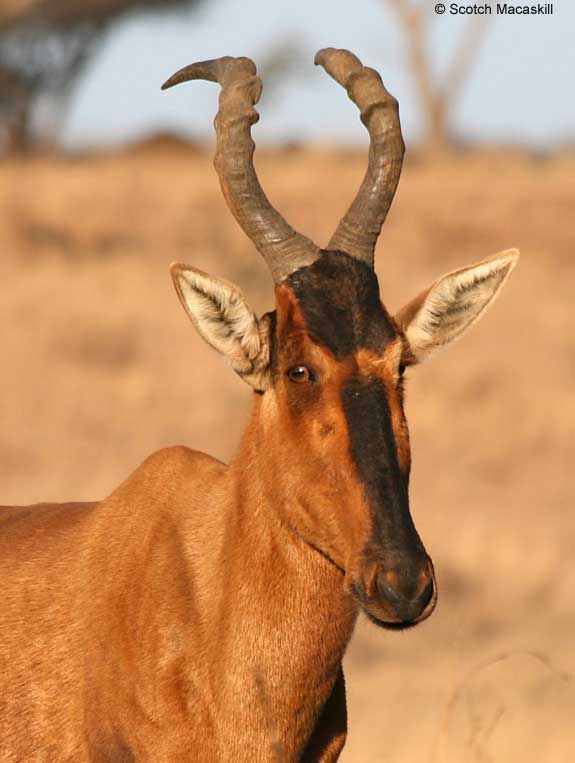
Photo Details: Red Hartebeest (Alcelaphus buselaphus) head and shoulder view, Spionkop Nature Reserve, KwaZulu-Natal, South Africa.
Camera: Canon EOS 400D; Lens: Canon 70-300 IS Zoom; Focal Length: 300mm; Shutter speed: 1/500; Aperture: f8; ISO: 200.
Additional Info: The red hartebeest is a large, hump shouldered antelope, with a shoulder height of about 130cm or 48". It's a rather awkward looking animal and lacks the elegance that one associates with most antelopes, yet is one of the fastest, reaching speeds of up to 60 kmh.
The long, narrow face is topped by heavily ridged horns that appear stubby and V-shaped when viewed straight-on (see picture right), but which actually curve forwards and then sharply back. Both males and females carry horns.
The coat is typically a glossy reddish-brown, while the rump is conspicuously lighter. Red hartebeest are principally grazers found in open grassland and were originally widely distributed before hunting and human habitation took their toll. They have been re-introduced in parts of KwaZulu-Natal, including Spionkop Nature Reserve.
Please Note: Pictures displayed on this blog are copyright protected. View them online, enjoy them, but kindly do not use them for anything else. Should you wish to purchase an image or require clarification on use, please contact me.
|
| |
| Back to top of page
|
|
Previous Entries
By Month
By Category
My Original Blog
2005 Entries
2004 Entries
2003 Entries
Who Am I?
Brief Bio
|








